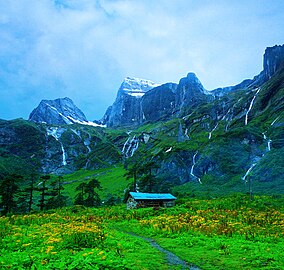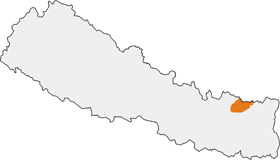Makalu Barun National Park
| Makalu Barun National Park | |
|---|---|
|
IUCN category II (national park)
|
|

Landscape in Makalu Barun National Park
|
|
| Location in Nepal | |
| Location | Nepal |
| Coordinates | 27°45′25″N 87°06′49″E / 27.75694°N 87.11361°ECoordinates: 27°45′25″N 87°06′49″E / 27.75694°N 87.11361°E |
| Area | 1,500 km2 (580 sq mi) |
| Established | 1992 |
| Governing body | Department of National Parks and Wildlife Conservation, Ministry of Forests and Soil Conservation |
The Makalu Barun National Park is the eighth national park in the Himalayas of Nepal and was established in 1992 as eastern extension of the Sagarmatha National Park. Covering an area of 1,500 km2 (580 sq mi) in the districts of Solukhumbu and Sankhuwasabha it is the world's only protected area with an elevation gain of more than 8,000 m (26,000 ft) enclosing tropical forest as well as snow-capped peaks. The bufferzone adjacent to the park's southern and southeastern border covers an area of 830 km2 (320 sq mi).
The rugged summits of Makalu, with 8,463 m (27,766 ft) the fifth highest mountain of the world, Chamalang (7,319 m (24,012 ft)), Baruntse (7,129 m (23,389 ft)) and Mera (6,654 m (21,831 ft)) are included in the national park. The protected area extends to about 66 km (41 mi) from west to east and to about 44 km (27 mi) from north to south. From the Arun river valley in the southeast, located at altitudes of 344–377 m (1,129–1,237 ft), elevation gains about 8,025 m (26,329 ft) to the peak of Makalu. The national park shares the international border with the Qomolangma National Nature Preserve of the Tibet Autonomous Region in the north.
The protected area is part of the Sacred Himalayan Landscape.
In the early- and mid-1980s, personnel of The Mountain Institute (TMI) conducted surveys in the Barun Valley to study the biological richness. The results of these surveys led to interest in creating a new protected area. A respective proposal was formulated in 1985. In 1988, the Makalu-Barun Conservation Area Project (MBNPCA) was initiated as a joint endeavor of the Department of National Parks and Wildlife Conservation and TMI.
...
Wikipedia

